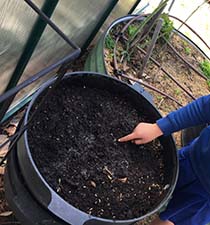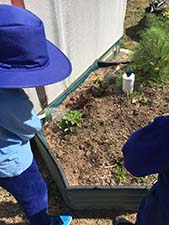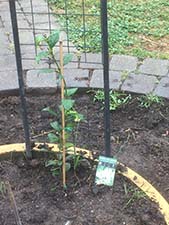Science, Sustainability and Culture at Mawson Primary School
During the year students focus on 4 subjects on a two-year rotation. Outcomes are based on the Science Curriculum achievement standards.
Even Year Odd Year
Term 1 Waste
Term 1 Water
Term 2 EnergyTerm2Waste Solutions
Term 3 Biodiversity Term 3 Indigenous cultures
Term 4 Climate Change
Term 4 Urban Wetlands
The importance of education for sustainability
Put simply, sustainability is about reducing our ecological footprint while simultaneously improving the quality of life that we value—the ‘liveability’ of our society. Education for sustainability is both present- and future-oriented. It’s about learning to design and implement actions for the present, in the knowledge that the impact of these actions will be experienced in the future. In this way it leads to students developing an overall capacity to contribute to “a more sustainable future in terms of environmental integrity, economic viability, and a just society for present and future generations”. In an era marked by concerns about the future of the planet, education for sustainability can be empowering, and an antidote to a sense of helplessness. It equips students to act, individually and collectively, in ways that can contribute to sustainability. It provides the opportunity for students to explore and evaluate contested and emerging issues, gather evidence, and create solutions for a sustainable future. Education for sustainability and culture can enable students to become effective citizens and active change agents by helping them to deal with complexity and uncertainty. It can also help them to understand that there is rarely a single solution because new knowledge is continuously generated, and diverse viewpoints exist in society.
Mawson aims to become a Five-star sustainable school
Implementing ‘Educating for Sustainability’ through the ACT Curriculum is further supported by ACTSMART to becoming a Sustainable School. This organisation provides ‘hands on’ step-by-step actions allowing our school to become more sustainable. The guide includes Walk-Through Audits and Best Practice Guides for water, waste, energy, biodiversity and education for sustainability curriculum. Examples - students becoming Energy Mites (Energy Conservation), Green thumbs (gardening) and Litter Legends (Waste).
Indigenous connections - during each subject area I aim to link in indigenous connections, with a major focus in Term 3 odd years.
Focus:
What do our students already know about the ways that indigenous people live and their relationship to our environment? Engaging our students in discussions about this issue and below is a series of questions that have helped guide my discussions (suggested answers included, Cool Australia):
*How did indigenous people in Australia feed, clothe and make shelter for themselves? – They used the plants and animals around them to satisfy all their needs, without taking more than they needed. Many indigenous people were nomadic, meaning they moved around rather than living in one spot.
*How do we do this differently? – We usually buy all that we need from shops. Products can come from anywhere in the world. Some things we buy were made on the other side of the world, this has negative impacts on the environment.
*How did indigenous Australians manage the landscape so that they could get what they needed and survive? – They never used up all of any one resource. If there weren’t enough all year round, they would move from one place to the next. They learnt from a young age about all the plants and animals around them and what they could be useful. As a result, they developed a respect for the importance of all living things and the interconnected relationship between all living things, including themselves.
*How do we do this differently? – Kids usually only know the names of a few plants and animals. That’s because adults spend very little time teaching kids these things. Most of us don’t really think about managing the landscape because we live in towns and cities and we have no direct need. We think instead about our jobs or schooling, how to make money and what to do with the things we buy.
*What changes were there in biodiversity when only indigenous people lived here? – The landscape’s biodiversity basically stayed the same. Yes, there may have been some use of fire but this was on a small scale and often helped support biodiversity.
*How have the landscape and the biodiversity of plants and animals changed since Europeans arrived? – Radically. Most of the most fertile areas around the coast have been stripped of their native vegetation to make way for farms, roads and the towns and cities we live in. Some species have already been lost and a lot more are close to being lost forever.
*What have been the major sources of these changes? – Land clearing and deforestation, and the introduction of non-native animals and plants.
*What could we learn from the way in which indigenous lived with the land? – Firstly, we should encourage a deeper appreciation of the interconnectedness of all living things, and more respect for and conservation of the natural landscape that we live in. Secondly, we should try to incorporate more teaching and learning about the natural landscape we live in by engaging more indigenous people in education.
Background Information
Educating for Sustainability through the ACT Curriculum has been developed to support the Australian Sustainable Schools Initiative (AuSSI). The AuSSI is a partnership between the Australian Government and the States and Territories to support schools to work towards a sustainable future. The initiative encourages a whole of-school approach to improve the management of facilities and resources including energy, waste, water and biodiversity. Becoming a sustainable school goes beyond awareness raising. It is action learning, supported by the development and implementation of sustainable practices that are embedded in the school curriculum and management plan.
Inquiry learning
Through active investigation students are encouraged to build on their knowledge associated with a particular environmental issue. This process involves planned, direct and indirect experiences, where students are encouraged to pose questions and gather information. They collect and analyse data in order to reach their own conclusions and decide upon appropriate courses of action e.g. students could conduct a survey of the school community to get their opinion of the school grounds. Students analyse data, draw conclusions and determine a course of action, such as creating habitats. After implementing the changes the students reflect on the outcomes of their actions and use the information to further plan. Learning experiences in the units of work have been grouped under the following broad headings: * tuning in * finding out * sorting out * going further * taking action * making connections * sharing discussion and reflection (Murdoch 2002; Wilson & Wing Jan 2003)
Useful links:
*Australian Museum: https://australian.museum/learn/cultures/
*Indigenous: https://www.abc.net.au/indigenous/
*https://www.actsmart.act.gov.au/




